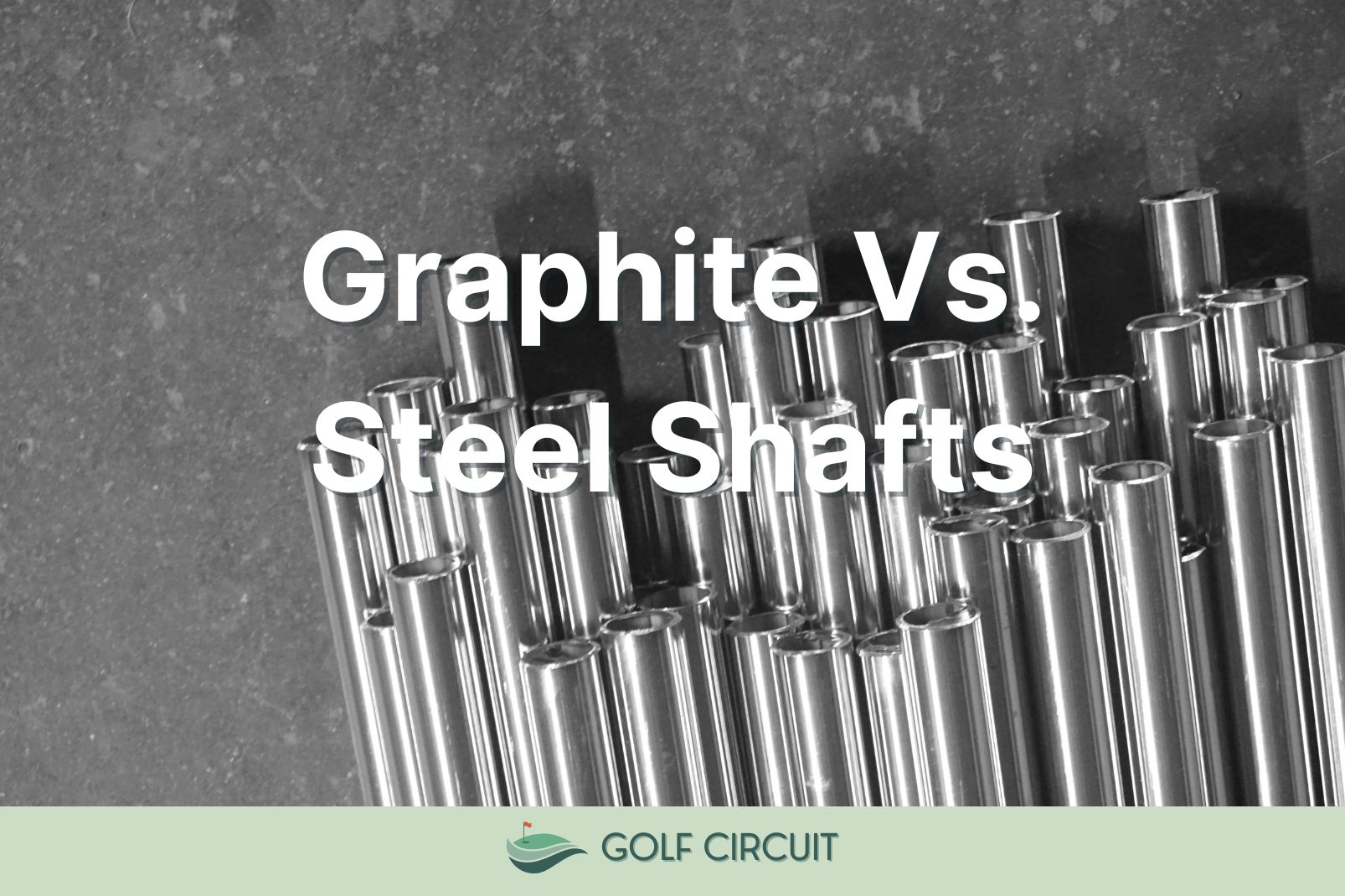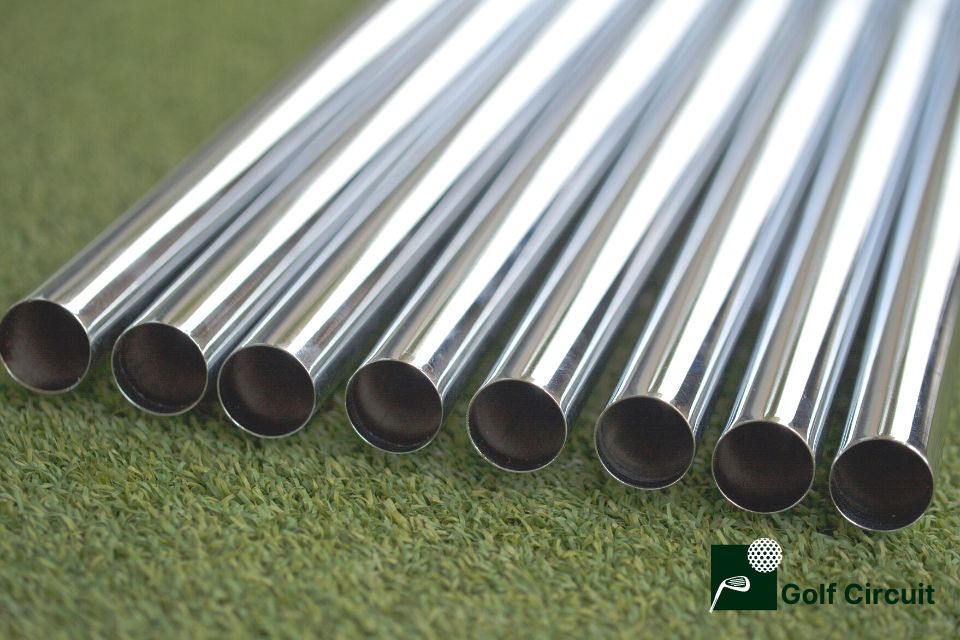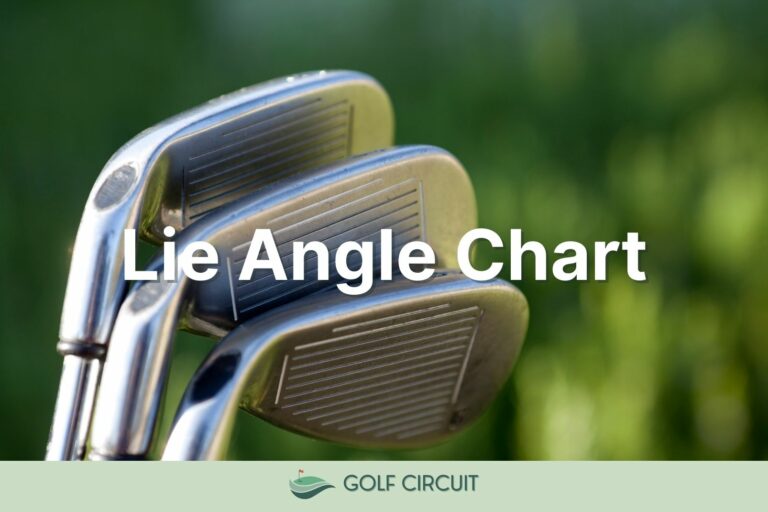Graphite vs Steel Shaft (Some Major Differences)

Every year golf manufacturers come out with new shaft options for players to choose from.
Years ago graphite shafts were considered the choice for higher handicappers, slower swing speed, and beginners.
Although this can still hold true in some situations, the graphite vs. steel question or debate is much more involved than this.
Understanding the differences between graphite and steel can help you become better equipped for the course.
Graphite vs. Steel Shaft Parameters and Characteristics

The biggest and most obvious difference between graphite and steel shafts is the materials that they are made of. However, because of the materials and the manufacturing process, the overall characteristics of the shaft will vary in weight, feel, ball flight, and more.
Weight
Generally speaking, graphite shafts are lighter than steel shafts.
However, with improved technology, the lightest steel shafts are now close to some of the heavier graphite shafts when it comes to weight.
This is excellent news for the higher swing speed players that need the extra weight but the benefits of a graphite shaft. Shaft weight is measured in grams and can usually be seen on the shaft.
Many shaft manufacturers will increase the weight of the shaft as the flex increases; keep this in mind as you shop.
In addition, golf shafts that are made for drivers are typically lighter in weight to help golfers get more clubhead speed; this is why they are all graphite.
In the irons and different types of wedges, when weight is a bit more important for consistency, you will see the clubs change over to a heavier total weight.
Feel
The feel of graphite and steel shafts is quite a bit different.
One of the things we love about steel shafts is that they give you quite a bit of feedback. If you hit a poor shot, you know it; if you hit a great shot, you are rewarded for it.
The steel shafts do not absorb quite as much of the vibration as a graphite shot will. This helps players continually strive to make solid contact with the golf ball.
Graphite shafts, on the other hand, provide a very smooth feel, even when the shot is not so great. For instance, you may hit slightly behind the ball even top it a little, and the feel in your hands is not nearly as harsh as it would be with a steel shaft.
This is why so many beginner clubs have graphite shafts; with all of the miss hits, the graphite helps to dampen any negative feel.
The good news for those who like a steel shaft is that golf equipment has come a long way. Steel is not necessarily harsh; it just provides more feedback than graphite and a firmer feel.
Feel should not be looked at as a negative for those that what a steel shaft, instead just a characteristic to consider.
Ball Flight
The ball flight can also be impacted by the graphite vs. steel shaft. Graphite shafts tend to have a higher launch creating golf shots that stay in the air longer.
Graphite shafts help players to create more speed and distance, but they aren’t always as easy to control.
Golfers that want to control their shots need a heavier steel shaft that keeps the ball a bit lower. Of course, steel shafts still allow for plenty of ball flight and the ball to stop on the green (due to having backspin on the ball), but golfers can learn to keep the ball flight more penetrating with steel.
If you are a golfer that likes to hit a lot of draws and fades or keep the ball low when approaching a green, the steel shaft is a better choice.
However, for players looking for pure distance and a big high shot, graphite will be the winner.
Don’t forget that your set of golf clubs can include both graphite and steel shafts so that you have a variety of shots that you can play.
Speed
Clubhead speed is essential to be able to get the distance. The more clubhead speed you can get, the easier it is to hit the ball a long way. However, clubhead speed is something that many golfers struggle with.
Over time players will work on various swing-related techniques to gain speed, but the equipment is typically the most important contributing factor.
Speed with graphite shafts is just easier to create.
Steel shafts are great for stronger players, but for golfers with slower swing speeds, it’s hard to get the speed you need to produce the shots you want.
If you struggle with speed but also want the benefits of a steel shaft, look for something that is much lighter in weight.
Length
Interestingly graphite shafts tend to be about a ¼ inch to a ½ inch longer than steel shafts. This won’t make a difference in the driver because almost all golfers use graphite shafted woods and hybrids.
However, in iron shafts, it can make a big difference, especially for shorter golfers.
The way graphite shafts are manufactured and produced; they almost always have an extra ¼ inch on the end of them the steel counterparts.
The good thing about extra length in an iron shaft is that it can give you a few more yards.
However, the bad news is that shorter players may have a more challenging time being consistent with the golf club. If you are going for a complete fitting for a new set of clubs, and end up with graphite, ask the custom fitter about the differences in length and if you need to be concerned.
Flex
The flex of the golf shaft you are using will range from senior and ladies’ shafts up to extra stiff shafts.
Graphite shafts are available in every flex.
Steel shafts are a bit more limited in that they don’t do much with the lady or senior shaft options. There are a few out there, but they are minimal.
Almost 100% of all senior and ladies’ shafts are graphite. This difference between graphite and steel ends up being a deciding factor for many golfers when it comes to which shaft they decide to play with.
What Type of Golf Shaft Should I Play?

Now that you have a better idea as to the differences between graphite and steel shafts, we will give you some insight as to which driver shaft is best for your game.
Of course, a custom club fitting will give you this information on a launch monitor and help you see the exact choice for your golf swing. However, these are some basic parameters to keep in mind.
Low Handicapper
Many lower-handicapped golfers have fast swing speeds. It’s an unfortunate truth in the game of golf that a certain amount of distance is necessary to get your handicap lower.
Low handicap golfers tend to be a bit more precise about their shots, and they look to control ball flight whenever possible.
This is why steel is the most popular choice for low handicap players. As these players age, they often switch from steel stiff flex shafts to steel regular.
In addition, you may see golfers put a graphite shaft in their 5-iron or 6-iron but leave the shorter irons and wedges in steel. A great player can tell you that the weight and feel of a steel shaft in the wedges is something that they need to succeed.
Mid Handicapper
Mid handicappers can choose either graphite or steel, but it is best to look at the strengths and weaknesses of the game before making a decision.
Distance is not your issue if you have tons of power and hit the ball past all of your friends.
However, if that power is difficult to control and the ball ends up in the woods have the time, the steel shaft could be a better choice.
Remember that power without control is kind of a wasted skill. Have your swing speed measured and consider the ball flight you want, and choose a golf shaft accordingly.
High Handicapper
Higher handicap golfers tend to struggle with distance and consistency. In addition, higher handicappers often hit more poor shots than lower handicap players.
Graphite shafts are usually selected to help improve the feel and overall consistency.
Higher handicappers need to be careful that they are playing with golf clubs that have some consistency; if you have graphite in the irons, put it in the wedges as well.
For higher swing speed and higher handicappers, the doors open up a little, and both graphite and steel can be looked at.
Beginner
Beginners almost always go with graphite or a very lightweight steel shaft. This is what the majority of beginner golf sets are made up of.
However, if you are a former athlete in another sport and have a fast swing speed, consider a custom fitting for a steel golf shaft.
The traditional beginner golfer who is entirely new to the game will play with graphite shafts for a few years.
Final Thoughts
Hopefully, you now understand the difference between graphite vs. steel shafts. Each of these golf shafts can offer you impressive performance in your game.
When finding the best golf ball or best driver, everything comes down to finding a match for your game.
Don’t choose a shaft because it’s supposedly the best on the market; choose one with the features and characteristics you need to succeed on the course.







Thanks for an EASY TO UNDERSTAND article! I’m a golfer on the wrong side of 70 and have seen my handicap dip from a 17 six years ago to its current 21.8. Still, I’m looking for additional insight to, at the very least, SLOW DOWN this decay of my golfing results. Some info I either knew (or strongly suspected) but much more insight from this article. Got me to thinking; junk knock off heads will not perform nearly as well as virtually any of the name brands but what about shafts??? Ping, Taylormade, Cobra, etc. all have years of proven experience in their heads but I’ve put little thought into shafts. If all the major company heads are good, could it be selecting the right shaft is even more important than the head of the company product I select? Thanks!